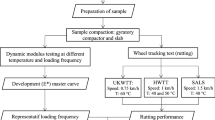Abstract
The development of new technologies and road pavement materials require the evaluation of the asphalt mixture performance. Rutting is one of the main modes of failure of asphalt mixtures; it is typically studied at the laboratory through the wheel tracking test (WTT). Weather and traffic conditions (temperature, loads) significantly affect the pavement rutting performance. The bitumen rheological properties also have a main role in mixture rutting response; they can adequately characterized by the bitumen Low Shear Viscosity (LSV). The estimation of rutting performance appears as a useful decision tool to optimize pavement design process. This paper studies the rutting performance of asphalts mixtures utilising the WTT. The specimens were tested at different temperatures and loading levels to simulate different climatic and traffic pavement conditions. A performance estimator was developed including temperature and traffic load on the pavement, and LSV of the binder as input data.








Similar content being viewed by others
References
Coleri E, Harvey J, Yang K, Boone J (2012) A micromechanical approach to investigate asphalt concrete rutting mechanisms. Constr Build Mater 30:36–49
Xu T, Huang X (2012) Investigation into causes of in-place rutting in asphalt pavement. Constr Build Mater 28:525–530
Akisetty C, Lee S, Amirkhanian S (2009) High temperature properties of rubberized binders containing warm asphalt additives. Constr Build Mater 23:565–573
Özen H (2011) Rutting evaluation of hydrated lime and SBS modified asphalt mixtures for laboratory and field compacted samples. Constr Build Mater 25:756–765
De Visscher J, Vanelstraete A (2009) Equiviscous temperature based on low shear viscosity: evaluation as binder indicator for rutting and critical discussion of the test procedure. In: Proceedings of the 7th international RILEM symposium ATCBM09 on advance testing and characterization of bituminous materials II:1009–1018. ISBN 978-0-415-55854-9
Morea F, Agnusdei J, Zerbino R (2011) The use of asphalt low shear viscosity to predict permanent deformation performance of asphalt concrete. Mater Struct 44:1241–1248. doi:10.1617/s11527-010-9696-3
Bahia HU, Delgadillo R, Motamed A, Christensen D (2009) Performance of modified asphalt binder and mixture under increased truck loading limits. In: Proceedings of the Efficient Transportation and Pavement Systems, pp 421–439. ISBN 978-0-415-48979-9
Delgadillo R, Bahia H, Lakes R (2012) A nonlinear constitutive relationship for asphalt binders. Mater Struct 45:457–473. doi:10.1617/s11527-011-9777-y
Kim YR (2009) Modelling of asphalt concrete. Editorial McGraw-Hill. ISBN 0-07-146462-X. doi:10.1036/007146462X
Bodin D, Grenfell J, Collop C (2009) Comparison of small and large scale wheel tracking devices. Road Mater Pavement Des 10(Supplement 1):295–325
Nikolaides A, Manthos E (2009) The effect of volumetric properties of asphalt concrete mixture to wheel track rutting with respect to EN and BS rutting test method. In: Proceedings of the 7th international RILEM symposium ATCBM09 on advance testing and characterization of bituminous materials II:1019–1028. ISBN 978-0-415-55854-9
Perraton D, Di Benedetto H, Sauzéat C, De La Roche C, Bankowski W, Partl M, Grefell J (2011) Rutting of bituminous mixtures: wheel tracking test campaign analysis. Mater Struct 44:969–986. doi:10.1617/s11527-010-9680-y
Silva H, Olivera J, Peralta J, Zoorob S (2010) Optimization of warm mix asphalts using different blends of binders and synthetic paraffin wax contents. Constr Build Mater 24:1621–1631
Morea F (2011) Deformaciones permanentes en mezclas asfálticas. Efecto de la reología de los asfaltos, la temperatura y condiciones de carga. PhD Thesis, La Plata National University
Morea F, Zerbino R, Agnusdei J (2012) Improvements on asphalt mixtures rutting performance characterization by the use of Low Shear Viscosity. Mater Struct. doi:10.1617/s11527-012-9900-8
ASTM D 6373 (1999) Standard specification for performance grade asphalt binder. J ASTM Int 04.03:713–715
De Visscher J, Vanelstraete A (2004) Practical test methods for measuring the zero shear viscosity of bituminous binders. Mater Struct 37:360–364. doi:10.1007/BF02481684
Partl M (2013) Advances in interlaboratory. Testing and evaluation of bituminous materials. State of the art report of the RILEM Technical Committee 206-ATB. RILEM Book. Springer, New York
UNE EN 12697-33 (2003) Bituminous mixture: test methods for hot mix asphalts, part 33: specimen prepared by roller compactor
BS 598 part 110 (1996). Sampling and examination of bituminous mixture for road and other paved areas—methods of test for determination of wheel tracking rate
Acknowledgments
The authors thank Claudio Veloso, Jorge Coacci, Norberto Amarillo and Javier Batic for their collaboration in the development of the experimental works.
Author information
Authors and Affiliations
Corresponding author
Rights and permissions
About this article
Cite this article
Morea, F., Zerbino, R. & Agnusdei, J. Wheel tracking rutting performance estimation based on bitumen Low Shear Viscosity (LSV), loading and temperature conditions. Mater Struct 47, 683–692 (2014). https://doi.org/10.1617/s11527-013-0088-3
Received:
Accepted:
Published:
Issue Date:
DOI: https://doi.org/10.1617/s11527-013-0088-3




